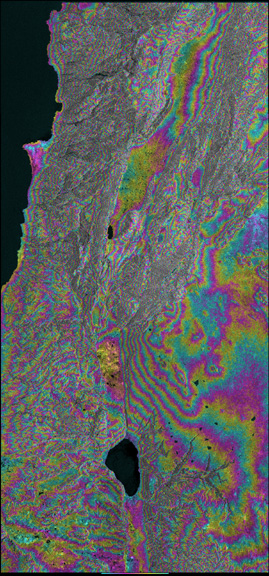Landsat Thematic Mapper and SPOT imagery are complemented by Synthetic Aperture Radar (SAR) data. In addition to the backscatter radar images, we have applied SAR Interferometry to produce a 20 meter pixel digital elevation model (DEM) of the Dead Sea fault system from the Jordan Valley northward until the junction with the East Anatolian fault. This high resolution DEM, in conjunction with other high resolution imagery, is being used for regional mapping of the Dead Sea fault system, as well as morphometric analyses to identify the possible distribution of neotectonic deformation. Some remote sensing examples are shown below.
 A map depicting the
extent of SAR data (provided by ESA). Both ascending and descending
orbits were used to image rugged parts of the terrain that result in layover,
foreshortening, and shadowing.
A map depicting the
extent of SAR data (provided by ESA). Both ascending and descending
orbits were used to image rugged parts of the terrain that result in layover,
foreshortening, and shadowing.
 An example
interferogram is shown at the left. Topography is the primary influence
on this interferogram, and each color fringe can be thought of as a contour
with an interval determined from the satellite baseline.
An example
interferogram is shown at the left. Topography is the primary influence
on this interferogram, and each color fringe can be thought of as a contour
with an interval determined from the satellite baseline.
 Shaded
relief image of the DSFS from the Jordan Valley to the southern Bekaa Valley
produced from a high resolution (20 m) digital elevation model (DEM).
The DEM was derived from interferometric processing of synthetic aperture
radar (SAR) imagery.
Shaded
relief image of the DSFS from the Jordan Valley to the southern Bekaa Valley
produced from a high resolution (20 m) digital elevation model (DEM).
The DEM was derived from interferometric processing of synthetic aperture
radar (SAR) imagery.
 A
3-D rendering of the central DSFS (Lebanon & western Syria showing
Landsat Thematic Mapper imagery is draped over a high resolution digital
elevation model (DEM).
A
3-D rendering of the central DSFS (Lebanon & western Syria showing
Landsat Thematic Mapper imagery is draped over a high resolution digital
elevation model (DEM).
Return to Dead Sea Project Home
For questions or comments, please contact Muawia Barazangi: mb44@cornell.edu.
Last updated: August 2006